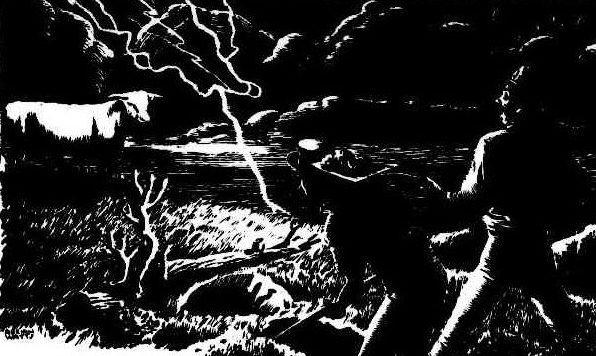
“Yesterday’s” columnist NICHOLE OVERALL tells the story ( “among the weirdest of the Canberra district”) of an 1876 murder and a phantom white bull…
ON the plains towards Yass, there’s a lonely hollow huddled at the base of picturesque hills, bounded by the mighty Murrumbidgee River known as “Washpen” – so called for its purpose in washing the sheep tended in the area.

Its nearest neighbour is “Yeumberra”, the almost 730-hectare Merino stud of Charles Hall since 1853.
At the close of June, 1876, police from the largest population hub, Queanbeyan, a good 60 kilometres distant, received a telegram requesting their presence in the isolated spot on fears of foul play.
Sure enough, the end of their sojourn was greeted with a blood-splattered hat.
Next, lying by the ashes of his campfire, young shepherd Jeremiah McCarthy (or Maloney) with “his skull blown off”.
As intimately detailed in “The Queanbeyan Age“: “In order to obliterate all traces of his crime, the murderer had removed the shattered portions of his victim’s head and face, and scooped out the brains through which were scattered the charge of slugs”.
The near headless form, with his rough woollen blanket as a shroud, was buried in a hasty grave, the boughs of a gunyah tree sheltering his “last earthly home”.
The murderer was unmasked as “Waterloo Tom”, a veteran of the 1815 battle and said to have distinguished himself in the defeat of the French Emperor Napoleon by the English Duke of Wellington.
About 60, harshly depicted as “6-foot-4-inches of ungainliness, with large flapping ears, scraggly beard, ferocious expression and baboon gait”, his real name was William Hutton. He’d made the shores of the new British colony in 1822.
Reputed to carry “a gun with a barrel six-feet long, and a sheath knife made from a scythe-blade”, he routinely boasted of having killed “thousands of men”.
In this instance, he initially proclaimed his innocence.
With evidence required for the trial, the unfortunate shepherd’s body needed to be exhumed.
Charged with the gruesome task was Sen-Sgt Martin Brennan, accompanying him, Constable James McIntosh and two policemen from Yass.
As they reached the site, suddenly, “an extraordinary cumuli stratus cloud, or ‘woolpack’ descended and enveloped the mountains and the Washpen in comparative darkness”.
Before a shovel touched the earth there came a teeth-rattling explosion followed by a deep rumbling reverberating through the darkened valley.
More than thunder; shouts of an earthquake.
Next, from the hills behind, a bellowing roar. Whirling about to see materialise “a huge bull of immaculate whiteness, a shadowy thing of rage”.
Charging in their direction, it moved at an incredible speed for its size and weight.
There could not be heard though, a single hoofbeat.
Diving for safety behind the trees, trembling hands drew revolvers.
There’d be no need for a single round to be fired. Reaching the open wound in the ground that bore the corpse of the unfortunate soul, the bull drew to a halt. Pawing forcefully, it lay down beside the grave, moaning piteously. Heaving a last, heavy sigh – it died.
Shaking in bewilderment, the policemen went on with their ghoulish task, if much more quickly than before.
Back in Queanbeyan, inquiries throughout the district as to ownership produced no claims. Nor did anyone know of such an animal to be found anywhere in the area.
Two days later, Constable McIntosh returned to bury the creature – only to find it had vanished, not a single sign of its presence.
Sgt Brennan would declare he was merely describing what four police officers, in full control of their faculties, observed in the middle of an otherwise ordinary day. None could explain precisely what had occurred, but agreed it to be a “psychological phenomenon”.
William Hutton stood trial at Goulburn in October, 1876. With motive unclear, he was found guilty and sentenced to death.
His military service saved him from the noose. Instead, 10 years of his life behind steel bars with the added burden of hard labour.
The tale, declared as “among the weirdest of the Canberra district”, didn’t quite end there.
Already deemed a “maniac”, bound in chains and enclosed in a tiny rock-bound space, so began his nightly tortuous screams of “being trampled to death by a great white bull”.
Also to emerge, a legend attached to the Halls of “Yeumberra”. On the death of one of their own, the appearance of a white bull.
This echos yet another famous example of the region’s unexplained similarly written up over time: the Black Horse of Sutton. The galloping beast is said to appear on the passing of members of a family from that locality.
Has then, the capital of a nation long had its very own harbinger of doom?
More real-life, local crime at Nichole Overall’s capitalcrimefiles.com.au
Who can be trusted?
In a world of spin and confusion, there’s never been a more important time to support independent journalism in Canberra.
If you trust our work online and want to enforce the power of independent voices, I invite you to make a small contribution.
Every dollar of support is invested back into our journalism to help keep citynews.com.au strong and free.
Thank you,
Ian Meikle, editor








Leave a Reply